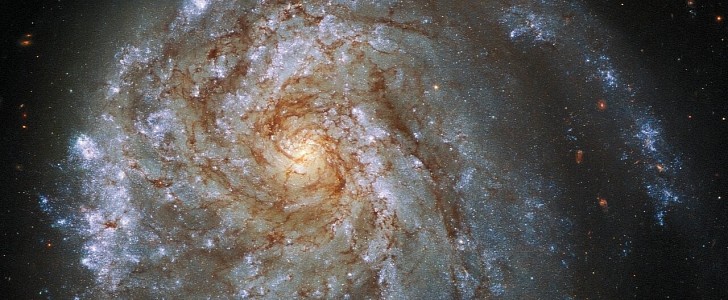The Hubble Space Telescope has spotted a weird-looking spiral galaxy that made it to the Atlas of Peculiar Galaxies for its strange appearance.
The spiral galaxy captured by the NASA/ESA Hubble Space Telescope was named NGC 2276 and is part of the Cepheus constellation, which is 120 million light-years away. But that’s not what makes it the oddity of the Universe.
Although it looks normal at first sight even to the trained eye, a more focused look at the star cluster revealed its contorted shape with distorted, lopsided spiral arms caused by its neighbor, galaxy NGC 2300.
The images captured by the Hubble telescope show the interaction between the two galaxies. The galactic neighbor NGC 2300 stretched the edges (called spiral arms) of our freak nebula because of its gravitational pull, making the latter look asymmetrical and as if it's orientated face-on to our planet.
The so-called spiral arms are a distinctive feature of these spiral galaxies and our own Milky Way has them as well. So does our neighbor, Andromeda.
There’s another reason why the NGC 2276 looks so "out of shape", literally, and that is the superheated gas that pervades galaxy clusters, which also affected its already strange looks.
The good thing about being a weirdo is the fact that you attract more than just other galaxies. The NGC 2276 also attracted the attention of the Atlas of Peculiar Galaxies, which is kind of a Guinness World Records book but for galaxies. It is a catalog started in 1966 in which you can find all the weird, unusual galaxies in the Universe, and the NGC 2276 spiral galaxy got listed in there twice. One listing was earned by its distorted, asymmetrical arms and the other one by the fact that it interacted with its neighbor.
The Hubble Space Telescope was launched in 1990 and it provides valuable insight into the universe, being a space-based observatory. It’s offered humanity countless stunning captures of remote galaxies, supernovas and so much more. The telescope is a collaboration between NASA and ESA (European Space Agency).
Although it looks normal at first sight even to the trained eye, a more focused look at the star cluster revealed its contorted shape with distorted, lopsided spiral arms caused by its neighbor, galaxy NGC 2300.
The images captured by the Hubble telescope show the interaction between the two galaxies. The galactic neighbor NGC 2300 stretched the edges (called spiral arms) of our freak nebula because of its gravitational pull, making the latter look asymmetrical and as if it's orientated face-on to our planet.
The so-called spiral arms are a distinctive feature of these spiral galaxies and our own Milky Way has them as well. So does our neighbor, Andromeda.
There’s another reason why the NGC 2276 looks so "out of shape", literally, and that is the superheated gas that pervades galaxy clusters, which also affected its already strange looks.
The good thing about being a weirdo is the fact that you attract more than just other galaxies. The NGC 2276 also attracted the attention of the Atlas of Peculiar Galaxies, which is kind of a Guinness World Records book but for galaxies. It is a catalog started in 1966 in which you can find all the weird, unusual galaxies in the Universe, and the NGC 2276 spiral galaxy got listed in there twice. One listing was earned by its distorted, asymmetrical arms and the other one by the fact that it interacted with its neighbor.
The Hubble Space Telescope was launched in 1990 and it provides valuable insight into the universe, being a space-based observatory. It’s offered humanity countless stunning captures of remote galaxies, supernovas and so much more. The telescope is a collaboration between NASA and ESA (European Space Agency).


